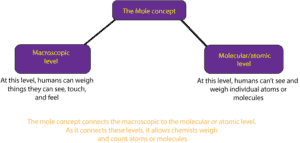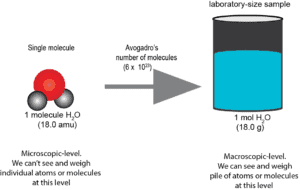Why do chemists need the Mole Concept?
Chemists need the mole concept to bridge the gap between the microscopic world of atoms to the macroscopic world of humans. As you know, the molecular level consists of particles that are invisible to us. Because of this, chemists can’t count or weigh these individual particles on a scale.
So, how do chemists get around this problem?
To solve this problem, chemists introduced the mole concept. The mole is the unit for the SI base quantity the Amount of Substance. And the mole concept connects the macroscopic to the atomic or molecular level. Let use the following model to illustrate:
What’s the Amount of Substance?
The Amount of substance is a quantity that measures the size of a pile (collection) of particles. These particles can be electrons, atoms, molecules, ions, or formula units. The amount of substance is an SI measured quantity that has a symbol n, and a base unit of mole, which is often written in a short way as mol.
What’s a Mole?
A mole is the size of a pile of particles (amount of substance) that contains as many particles (electrons, atoms, molecules, ions, or formula units) as there are atoms in 12 grams of carbon-12 (an isotope of carbon). Therefore, a mole or
1 mole of carbon-12 = 12 grams of carbon-12
What amount of substance can have the same number of particles as in 12g of carbon-12? The amount of substance that can have the same number of particles include:
- atomic mass of an element expressed in grams
- molecular mass of molecular compounds expressed in grams
- formula mass of ionic compounds expressed in grams
What do we mean by the atomic mass expressed in grams?
It means that we take the relative atomic mass values of all the elements on the periodic table and attach grams to them. Once we do that, we can now weigh 1 mole of any element by simply weighing its exact atomic mass in grams. Similarly, since atoms combine to make molecules, we can find the molecular mass of any molecule by simply finding the sum of all the atomic masses in the chemical formula. The following table shows how to transition from atomic mass (amu) to molar mass (g/mol).
Why is it that 1 mole of any element has the same number of particles as in 1 mole of carbon-12?
They do because of Avogadro’s hypothesis, and recall that it was his hypothesis that helped scientists determine the relative atomic masses of the elements.
Now, how many particles (atoms, molecules, or ions) are in 1 mole of a chemical substance? There are 6.02 x 1022 particles in 1 mole of any chemical substance. As you can see, this number is so huge that it has a special name called the Avogadro’s number in honor of Avogadro; The Italian mathematician who contributed to our understanding of the mole concept.
Mathematically, we can write a relationship between 1 mole, Avogadro’s number, and atomic mass in grams. For example, we can write that 1 mole of carbon is equal to 12 g of carbon and in this 12 g there are 6.02 x 1022 atoms of carbon. If we translate that to a mathematical expression, we will get;
- 1 mole = 12 g = 6.02 x 1022 atoms of carbon.
If we divide through by 1 mole, we will get two ratios:
- 12 g/1mole
- 6.02 x 1022 atoms of carbon/1mole.
The ratio 12 g/1 mole or 12 g/mol (read as grams per mol) has a special name called Molar Mass. So, the molar mass is simply the mass of 1 mol of a substance in grams. As a result, the only number that will keep changing from substance to substance is the mass of 1 mole of substance (see text in bold). Now, if you need to convert some certain grams of carbon to atoms of carbon or atoms of carbon to grams of carbon, the two ratios, or conversion factors we just derived are the ones we will use.
Here is a model that shows the relationship between Mass, Mole, and Avogadro’s number
How is the mole related to the dozen?
We can relate the mole to the counting unit: Dozen. We buy eggs by the dozen, we buy soda by the dozen, we buy many things by the dozen, and we know that a dozen always contains 12 things. However, as we buy a dozen of this and a dozen of that, the only number that keeps changing is the mass of the items in the dozen. As a result, we can write a mathematical expression similar to the mole one. Let’s say if a dozen eggs weigh 10 g, then we can write something like this: 10 g = 1 Dozen = 12 eggs. If we divide through by 1 Dozen, we will get two ratios:
- 10 g/1Dozen and
- 12eggs/1Dozen,
These ratios are the ones we will use to convert from grams of eggs to Dozen of eggs to number of eggs and in reverse order.
Once you understand how grams of substance relate to moles, how moles of substance relate to Avogadro’s number and vice versa, you will always find mole problems easy to solve. Here is a diagram summarizing these relationships.
If you want to learn how to calculate the number of atoms in an element, click here
Check you understanding
- If you have a sample of 10 mol of carbon dioxide (CO2), how many molecules of CO2 are in the sample?
- Calculate the molar mass of sulfuric acid (H2SO4)
- If you have a sample of 5.0 g of sulfuric acid, how many mol of sulfuric acid are in the sample?




